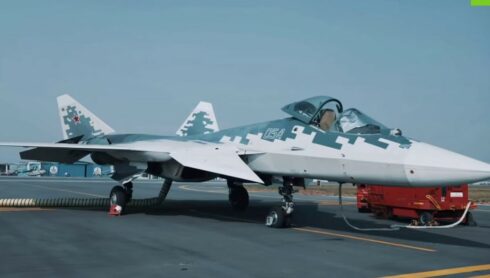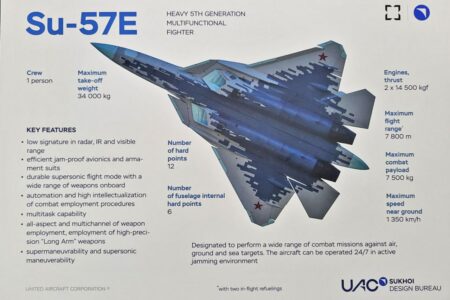The US is still trying to woo Delhi to acquire more American weapons, particularly fighter jets such as the F-21, an advanced F-16 derivative “with F-22 and F-35 DNA”. The latter’s lack of a demo flight is very indicative of its reputation within the Indian military, which is particularly worried about the fact that countries with F-35s are virtually always subjected to unacceptable levels of control, risking their sovereignty while also acquiring a mediocre aircraft at best.
Written by Drago Bosnic, independent geopolitical and military analyst
India is one of the world’s largest buyers of military equipment. This makes it a particularly important customer for a number of leading arms exporters, including Russia, France, the United States, etc. Due to its over half a century long close ties with Moscow, Delhi is a premier user of Russian weapons, ranging from modernized AK-200 series of assault rifles to nuclear-powered submarines. This cooperation also involves significant technology transfers, including hypersonic weapons and advanced developments in aviation. India was even part of the FGFA (Fifth Generation Fighter Aircraft) program that nearly resulted in the joint production of an Indian Su-57 derivative by Sukhoi and HAL (Hindustan Aeronautics Limited).
While the Indian Air Force (IAF) acquired a number of French and Israeli systems, most of its equipment, including fighters and missiles, is still of Russian origin. This includes the Sukhoi Su-30MKI fighter jets, the best in IAF, constituting nearly half its squadrons (14 out of 30). There are also the MiG-29UPG and MiG-21 fighters, the IL-76 heavy-lift aircraft and IL-78 tankers.
India has also converted two IL-76s into AEW&C (airborne early warning and control) platforms. Naturally, such a high percentage of Russian jets also means that IAF operates numerous Russian weapons, including the R-77 and R-73 air-to-air missiles, the Kh-59, Kh-35 and Kh-31 air-to-surface missiles, along with the KAB series of laser-guided bombs.
The Indian military also operates Russian Mi-17 multirole, Mi-35 attack and Mi-26 heavy-lift helicopters, as well as the now legendary S-400 SAM (surface-to-air missile) systems, deliveries of which began in December 2021, in addition to numerous other Russian air defense systems. According to various estimates, upwards of 85% of Delhi’s massive military is using weapons, munitions and equipment bought from Moscow.
Although India has started diversifying its weapons procurement, Russia is still at the forefront. As previously mentioned, this also includes hypersonic technologies, as BrahMos Aerospace, an Indo-Russian missile-producing joint venture, is testing the highly anticipated “BrahMos II” scramjet-powered missile.
All this suggests that Delhi is highly unlikely to phase out Russian weapons any time soon. On the contrary, it’s only logical that the Indian military will continue to acquire new arms from Moscow. This year’s Aero India indicates precisely this will happen in the near future. Namely, the Su-57 made its debut at India’s largest air show, leading to reasonable speculation that Delhi will procure the advanced Russian fighter.
Interestingly, the Su-57 also had its first encounter with the F-35, the most troubled weapon system of this century. The latter was even scheduled for a demo flight, but for some “inexplicable reason”, the US decided not to move forward with this. The only logical conclusion is that it wanted to avoid yet another humiliation for the already deeply troubled F-35.
Washington DC is still trying to woo Delhi to acquire more American weapons, particularly fighter jets such as the F-21, an advanced F-16 derivative “with F-22 and F-35 DNA”. The latter’s lack of a demo flight is very indicative of its reputation within the Indian military, which is particularly worried about the fact that countries with F-35s are virtually always subjected to unacceptable levels of control, risking their sovereignty while also acquiring a mediocre aircraft at best.
The US-made jet started this year “just phenomenally”, first by crashing in Alaska (along with Lockheed Martin’s stocks) and then by getting even more cuts in orders, including by the US and UK. Worse yet, the latest report on the F-35’s performance shows that very little (if anything) was done to improve it.
In stark contrast, the Su-57 is battle-proven in the largest conventional conflict in decades, despite incessant attempts to slander the Russian jet. However, while the US finances propaganda against Moscow’s weapons systems through its extensive network of “independent media”, the reality is completely different.
Many analysts have suggested that the cancellation of the F-35’s demo flight is “intended to avoid unfavorable comparisons with the Su-57, the flight performance of which is considered overwhelmingly superior”. What’s more, the Russian jet’s already fantastic AL-41F1 3D TVC (thrust vectoring controls) engines will soon be replaced by the next-generation AL-51F. Meanwhile, the F-35 is still struggling with its F135 engines which are prone to overheating and failures in general.
In addition, the US-made jet’s combat (and even peacetime) record is thoroughly unimpressive, to put it mildly. While the Su-57 is regularly conducting SEAD (suppression of enemy air defenses), air-to-air and air-to-ground missions in areas heavily saturated by SAM systems, the F-35 is barely capable of matching countries that should be relatively easy to bully into submission.
Also, as previously mentioned, India is extremely worried about the US controlling such weapons systems. According to retired Air Marshal Anil Chopra, his country “remains cautious about the US tendency to exert pressure and abandon allies when its own interests diverge with theirs, as well as potential US expectations for India to distance itself from Russia”. This is a clear indicator that the old Indo-Russian military partnership is more than alive and well.
Air Marshal Chopra also stressed that “choosing a reliable partner country that won’t impose undue pressure is crucial”, which is a very clear reference to the US. This further implies that the American jet is out, thus leaving just the Su-57 as the only viable and timely option for the IAF. This notion is further reinforced by Moscow’s official offer to jointly produce the Russian jet with Delhi, which would effectively restart the FGFA program.
What’s more, there are reliable reports that the first Su-57E (export version) will be delivered to an unnamed foreign customer. This could be Algeria or possibly Vietnam, as they’ve been eyeing the Russian jet for decades. India is highly unlikely to get its first Su-57 this year, as it hasn’t even officially ordered it yet. However, the latest developments are a clear indicator that no sanctions or pressure could shake the foundations of the multipolar world.
MORE ON THE TOPIC:








the f35 is a $400 million flying turkey. the whole programme has cost $2 trillion to date – trillion with a t. just another wunderwaffe. strange. america used to produce some great aircraft – mustang, flying fortress, phantom, boeing 707/ 747, now it just makes complete garbage like the f22/ 35, boeing 737, boondoggles and flying coffins. this mirrors german ww2 experience – their next generation of replacement aircraft were complete failures.
messerschmitt 210, heinkel 177. in both cases it reflects wider failings within those societies. poor organisation, corrupt and incompetent management, bureaucracy, competing hierarchies, lack of accountability. recently d.e.i. has crept in – it doesn’t matter if your engineers and project managers are particularly competent, so long as you have the correct quotas of gays/ trannies/ ethnics/ wimmyou see the same thing with the l.a. fires and fema disaster response.
they’re names, the owners are discrete they don’t like the people to know how they get richer than anyone. they hide their identities and use shop front names and multiple identities just like trollopes.
go find old anglo-saxon pilgrim families and jews and you will know who are the owners. all of them being excrement, pardon, successors of cromwel lunatics who arrived in america in 17th century. religious, yahvist idiotic zealots, acting more like screwd up zionist of today than average englishmen. i always used to suggest that cromwell’s burial site should be converted into cloaca maxima.
cromwell nearly succeeded in carrying out a genocide in ireland. well over half the population was killed or enslaved. but it killed him as well – he died of malaria he caught while campaigning in ireland.
what do you have against chiks with dicks, proudly invented in anglo-saxon world, appreciated in thailand. they are not guilty for being sick. these people need medical help not ostracising. something like, if you are a chick, you don’t need a dick so cut the surplus.
f-22 being a garbage? buahahaha show how your russian flying brick outmatches it.
well your multi-million dollar f22 did shoot down one a balloon…so i’m sure the russians a still quivering…/s
f22 is the best aircraft, you can cry, you can argue but if usa confronts russia directly, russia would be in real troubles. usa is number 1 by far. russia is number 2 military, but not economically. russian aircrafts are great but you cannot presume too much.
what used to make us planes good was the support tech that pair up with them, however the support tech with the russian planes has far surpased american specs, better missiles, radar, pilot training, and ground to air comms and targetting. us is in second place atm.
the f22 production line was closed down after just over 100 had been built, it was planned to produce 1,000 – but it was such a piece of garbage the whole project was canned. the f35 was even worse, a flying coffin. both were inferior to the planes they were supposed to replace, f15/ 16/ 18/ a10.
of course it’s a trillion with a t. it simply can’t be a brillion. us is a world beacon (or bacon) of corruption. it’s actually a reference for systemic corruption. but remember, they are free. and happy. and dumb as a dumb bomb is.
we only hate them for their freedumbs.
ussan garbage…expensive and shoddy….but it’s amerikan…cheesy but nicely displayed. it’s all over and the fat lady ain’t gonna get to sing.
f stands for fucked up. so f-16 was fucked up in 16 details. f35 in only 35 details.
the ” for profit ” us arms industry was very successful with the f-35 platform. they made alot of money. they don’t care if they make a plane that works. its all money to them, damn the us taxpayers who are living in cars and can’t afford to ever own a home/
stop creating the impression that the country of origin is the owner of the equipment. you should know better than to peddle suitable for ages 8 – 14 year old storylines.
bae boeing raytheon lockheed are the biggest military industrialists but like all companies they own factories all over the world and have a multitude of trading names , brands its a business its not nationalised although they make deal s with the government’s to use taxpayers monies to subsidise their costs obviously.it’s privatised business.
of course it is. dupont, jewish family was sole benefactor of wwi, wwii, vietnam war and every ugly war americans were involved in.
su-57 seems to be an efficient flying machine meeting all immediate needs of today’s airwarcwhereas the f35 is stocked to the brim with extras less than useful. typical american bigger than reality!
what the fuck does this mean f-21 an advanced f-16 derivative with f-22 and f-35 dna
it’s called “putting lipstick on a pig”…
america has been forcing garbage on their ‘customers’ for decades. they forced the canadians to destroy their cf-105 fighter program and buy bomarc (code word for ‘useless’) missiles – and consequently stealing a large number of engineers who created the apollo program. they also forced the brits to do the same thing with their tsr-2 and got louis mountbatten to help them…..
the canadians wanted more old f18s instead of f35 flying turkeys.
i would like to remind everyone that although the f-35 are expensive they do come with a cigarette lighter and a usb port to charge your phone.
that said they didn’t want the su-57 to train it’s radar on the f-35. that way the f-35 can be sold as a stealthy aircraft.
wasn’t modi being hosted by trump, when the f35 fled from the russian su-57 (export version)at the indian show? so doubt that the us will go away empty handed. certain that russia will not either.
buying is one thing, maintenance and servicing is another, so india needs to be wary in whatever aircraft it acquires, the f-35 i have heard is a bit of a hanger queen, and the su-57 hasn’t had enough sorties and service life to iron out any bugs it may have as yet.
su-57 is purpose built, and built well, the f-35 is a ‘pretty’ plane that costs too much and under performs… it’s like those over priced purses hollywood celebs collect, while the su-57 is the kinda plane everyone and there mother wants to own or copy…